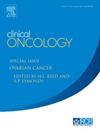Neuroendocrine Deficits and Weight Development Before and After Proton Therapy in Children With Craniopharyngioma
IF 3.2
3区 医学
Q2 ONCOLOGY
引用次数: 0
Abstract
Aims
Our objective was to analyse tumour- and treatment-related factors influencing endocrine morbidity and obesity pre- and post-proton beam therapy (PBT) in paediatric patients with craniopharyngioma.
Materials and methods
A total of 65 patients at the onset of PBT were included in the analysis within our prospective registry study. The data pertaining to endocrine deficits and BMI prior to PBT were retrieved from the medical records on a retrospective basis. Cumulative incidences (CI) of endocrinopathies, age- and sex-adjusted BMI standard deviation scores (BMI-SDS) were calculated.
Results
Before PBT, 90.8% had ≥1 neuroendocrine deficit. Diabetes insipidus (DI) was attributed to surgery in 96%. Patients with postoperative DI had a higher 3-year CI of adrenocorticotropic hormone and thyroid-stimulating hormone deficiency rates compared to those without DI (p < .001). At PBT start, 47.7% had already panhypopituitarism compared to 67.7% at the last follow-up (FU). Median FU post-PBT was 3.2 years (range, 1.0–9.6). Post-PBT, 38.2% remained free of additional hormone deficiencies. A trend towards lower endocrine morbidity scores for patients who received PBT during their primary treatment compared to irradiation at progression did not reach statistical significance (p = .068). The BMI-SDS increase from diagnosis to the start of radiotherapy was significantly greater than from the start of PBT to the end of FU (mean BMI-SDS increase: 0.61, ±1.16 vs. 0.13, ±0.84, p = 0.019), with a median time of 10.2 and 38.4 months, respectively. In the multivariate analysis, hypothalamic involvement (p = .042) and the BMI-SDS level at diagnosis (p = .006) were identified as clinical factors indicating severe obesity at FU (BMI-SDS ≥+2).
Conclusions
Panhypopituitarism is frequently observed in paediatric patients with craniopharyngioma prior to PBT. The potential benefits of early PBT on endocrine outcomes require further investigation through longer FU periods. The greatest increase in weight occurred before radiotherapy. Endocrine deficiencies and weight gain are multifactorial and require close monitoring.
儿童颅咽管瘤质子治疗前后的神经内分泌缺陷和体重发展
目的:我们的目的是分析影响儿科颅咽管瘤患者质子束治疗(PBT)前后内分泌发病率和肥胖的肿瘤和治疗相关因素。材料和方法在我们的前瞻性登记研究中,共有65例PBT发病患者被纳入分析。在回顾性的基础上,从医疗记录中检索与PBT之前的内分泌缺陷和BMI有关的数据。计算内分泌疾病的累积发生率(CI)、年龄和性别调整后的BMI标准差评分(BMI- sds)。结果PBT前,90.8%的患者神经内分泌缺陷≥1。尿崩症(DI) 96%归因于手术。术后DI患者促肾上腺皮质激素和促甲状腺激素缺乏率的3年CI高于未DI患者(p <;措施)。在PBT开始时,47.7%的患者已经患有全垂体功能减退症,而在最后一次随访(FU)时,这一比例为67.7%。pbt后中位FU为3.2年(范围1.0-9.6)。在pbt后,38.2%的人仍然没有额外的激素缺乏。在初始治疗期间接受PBT的患者与进展时接受放疗的患者相比,内分泌发病率评分较低的趋势没有达到统计学意义(p = 0.068)。从诊断到放疗开始的BMI-SDS增加明显大于从PBT开始到FU结束的BMI-SDS增加(平均BMI-SDS增加:0.61,±1.16比0.13,±0.84,p = 0.019),中位时间分别为10.2和38.4个月。在多因素分析中,下丘脑受累(p = 0.042)和诊断时BMI-SDS水平(p = 0.006)被确定为FU (BMI-SDS≥+2)时严重肥胖的临床因素。结论小儿颅咽管瘤患者在PBT前常出现垂体功能低下。早期PBT对内分泌预后的潜在益处需要通过更长的FU周期进行进一步研究。体重增加最多的发生在放疗前。内分泌不足和体重增加是多因素的,需要密切监测。
本文章由计算机程序翻译,如有差异,请以英文原文为准。
求助全文
约1分钟内获得全文
求助全文
来源期刊

Clinical oncology
医学-肿瘤学
CiteScore
5.20
自引率
8.80%
发文量
332
审稿时长
40 days
期刊介绍:
Clinical Oncology is an International cancer journal covering all aspects of the clinical management of cancer patients, reflecting a multidisciplinary approach to therapy. Papers, editorials and reviews are published on all types of malignant disease embracing, pathology, diagnosis and treatment, including radiotherapy, chemotherapy, surgery, combined modality treatment and palliative care. Research and review papers covering epidemiology, radiobiology, radiation physics, tumour biology, and immunology are also published, together with letters to the editor, case reports and book reviews.
 求助内容:
求助内容: 应助结果提醒方式:
应助结果提醒方式:


